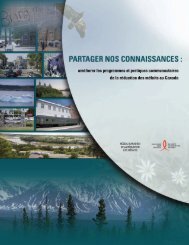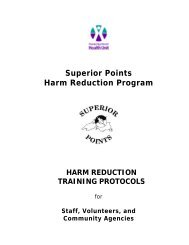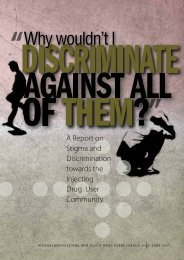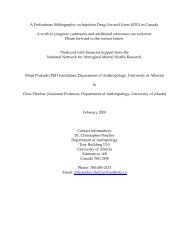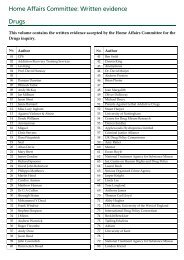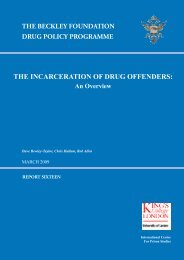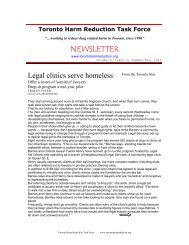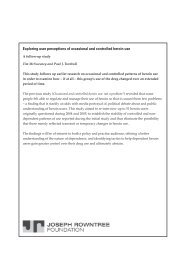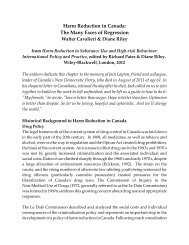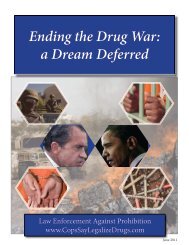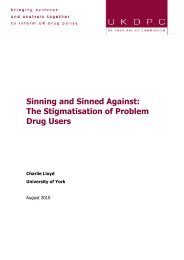Canadian Journal Addiction Medicine - Canadian Harm Reduction ...
Canadian Journal Addiction Medicine - Canadian Harm Reduction ...
Canadian Journal Addiction Medicine - Canadian Harm Reduction ...
Create successful ePaper yourself
Turn your PDF publications into a flip-book with our unique Google optimized e-Paper software.
November 2012<br />
where methadone was ingested by mouth. Artificial respiration<br />
was provided in four cases (44%); a pocket mask was used in<br />
two cases (22%). Chest compressions were administered in<br />
two (22%) cases. In all cases a clean needle and syringe were<br />
used to administer the naloxone and in eight (89%) cases an<br />
alcohol swab was used to clean the skin prior to injection.<br />
The reference card was used in three (33%) cases. Users<br />
were trained to administer a second dose of naloxone in five<br />
minutes if there was no response to the first dose; however, a<br />
second dose was only required in one case.<br />
Despite eight of nine participants reporting that a phone was<br />
nearby at the time of naloxone administration, EMS were only<br />
activated once. Reasons cited for not activating EMS were:<br />
person woke up with the naloxone and/or the person decided<br />
to watch them on their own (2, 22%); concern that the police<br />
would become involved (1, 11%); thought the person would<br />
recover unaided (1, 11%); and concern that someone would<br />
be blamed for the overdose (1, 11%). In the cases where EMS<br />
were not activated, all naloxone recipients were observed by<br />
study participants for longer than 90 minutes (the half life of<br />
naloxone), in case the symptoms of overdose recurred after<br />
the naloxone wore off. In all cases the recipient was reported<br />
to have survived the overdose.<br />
Study participants who administered naloxone felt they had<br />
enough training (8, 89%) and only one person reported that<br />
they felt unsure what to do. The majority of participants (8,<br />
89%) said that they would administer naloxone again in the<br />
same situation. No one reported using any of the supplies in<br />
the naloxone kit for other purposes.<br />
At one year, only 15 (30%) of individuals were available for<br />
follow-up. All participants rated the training they received in<br />
the naloxone program as worthwhile. Thirteen (87%) were still<br />
using opioids; however 11 (73%) reported that their drug use<br />
had decreased since their naloxone training. No one reported<br />
that his or her drug use had increased. This was supported by<br />
a pre- and post analysis on those subjects for whom follow up<br />
data were available: regular use of morphine, hydromorphone,<br />
oxycodone, cocaine and benzodiazepines during the past<br />
six months decreased among participants (Table IV). No<br />
additional reports of naloxone use were identified during the<br />
follow up surveys.<br />
Discussion<br />
In this first <strong>Canadian</strong> pilot program, fifty clients of a needle<br />
exchange program were trained in overdose recognition,<br />
basic life support measures and naloxone administration;<br />
they successfully administered naloxone nine times in the<br />
community setting over a one-year follow up period.<br />
This study supports previous evidence that users of illicit drugs<br />
are interested in learning more about overdose and in helping<br />
themselves and others (23). Significant barriers, however, still<br />
prevent the activation of EMS - EMS were only activated once<br />
during the course of this study. This was similar to a US study<br />
where EMS were called in only two of twenty communitybased<br />
naloxone administrations (9). Concern about police<br />
involvement and being blamed for the overdose were cited<br />
as reasons for not calling EMS. Previous local data suggests<br />
37% of people avoid calling EMS some or all of the time<br />
when an overdose occurs (23). Australian studies (26) have also<br />
documented high rates of EMS avoidance. While engaging<br />
both EMS providers and illicit drug users in a discussion on<br />
how to reduce the barriers to EMS activation should be an<br />
essential next step, ensuring that training programs impress<br />
upon participants the need for continued observation is also<br />
of paramount importance.<br />
Importantly and coincidently, while this program did not<br />
encourage participants to change their own drug use patterns,<br />
at follow up 73% of available participants reported a reduction<br />
in their own drug use after receiving naloxone training. Similar<br />
effects in other studies have been observed: participants in Los<br />
Angeles reported that they decreased their drug use (10) and in<br />
San Francisco the frequency of heroin injection was found to<br />
decrease six months after naloxone training (9). This suggests<br />
that training regular drug users in naloxone use may result<br />
in improved health outcomes for both trainees and those that<br />
they assist. This trend warrants further study.<br />
This study has several limitations. It is limited by a small<br />
sample size. The convenience sample methods may have<br />
caused selection bias whereby the clients enrolled in the study<br />
may not accurately represent all individuals who regularly use<br />
opioids or access needle exchange programs. Our one-year<br />
follow up (15/50, 30%) was low; however, this is comparable<br />
to similar studies in this target population (11). Due to lack<br />
of a control group, we are also unable to comment on this<br />
program’s impact on health-care related outcomes like<br />
mortality. While all participants who received naloxone were<br />
either observed in the community or transported by EMS<br />
and no deaths were reported, it is unknown whether these<br />
individuals would have died without a naloxone program.<br />
Finally, we were unable to systematically track missed cases<br />
of community-based naloxone administration by EMS,<br />
hospital or medical examiner records. Controlled studies with<br />
comprehensive community-wide tracking of opioid-overdose<br />
related deaths are warranted to determine if these programs<br />
can reduce the high mortality rates associated with chronic<br />
illicit opioid use.<br />
The community-based naloxone program described here has<br />
6



